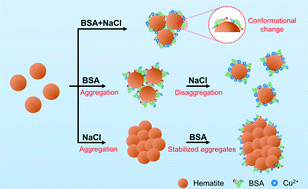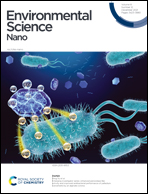Reversing the order of changes in environmental conditions alters the aggregation behavior of hematite nanoparticles†
Abstract
Nanomaterials may undergo a series of changes in environmental conditions during their long-distance transport in aquatic systems, but most aggregation studies were conducted under fixed conditions. How the order of the condition changes in natural waters affects the aggregation behavior of nanomaterials remains unclear. We investigated the aggregation behavior of 41 nm hematite nanoparticles, when they were exposed to bovine serum albumin (BSA, 2–56 mg L−1) and NaCl (10 mM or 100 mM) in three different exposure orders: simultaneous addition of NaCl and BSA (BSA + NaCl), addition of BSA first and then NaCl (BSA → NaCl), addition of NaCl first and then BSA (NaCl → BSA). At high ionic strength ([NaCl] = 100 mM), the attachment efficiency (α) monotonically decreased with the increase of BSA concentration ([BSA]), until a complete stabilization was reached. The minimum [BSA] needed for the complete stabilization of hematite nanoparticles and also the final hydrodynamic diameter (Dh) were in the order: BSA → NaCl < BSA + NaCl ≪ NaCl → BSA. Initial aggregation by addition of BSA and subsequent disaggregation by addition of NaCl were observed in the experiments of BSA → NaCl at [BSA] = 16–32 mg L−1. However, the reverse exposure order (NaCl → BSA) led to the formation of large aggregates after the initial addition of NaCl, and the subsequent amendment of BSA quenched further aggregation. The different α and Dh values observed in the experiments of BSA → NaCl versus BSA + NaCl can be attributed to different adsorption amounts and conformational changes of BSA on the hematite surface, resulting in the different steric repulsion between BSA–hematite conjugates. The adsorption capability of BSA–hematite conjugates for Cu2+ is consistent with their Dh values, suggesting that the reverse exposure orders of BSA and NaCl affect the aggregation behavior and metal-uptake capabilities of nanoparticles. Our findings reveal how the order of condition changes in natural waters affects the adsorption kinetics and conformational changes of proteins on the nanoparticle surface, resulting in the different interparticle forces and aggregation behaviors of nanoparticles, which can be essential to predict and understand the long-term mobility and fate of nanoparticles in aquatic systems.



 Please wait while we load your content...
Please wait while we load your content...